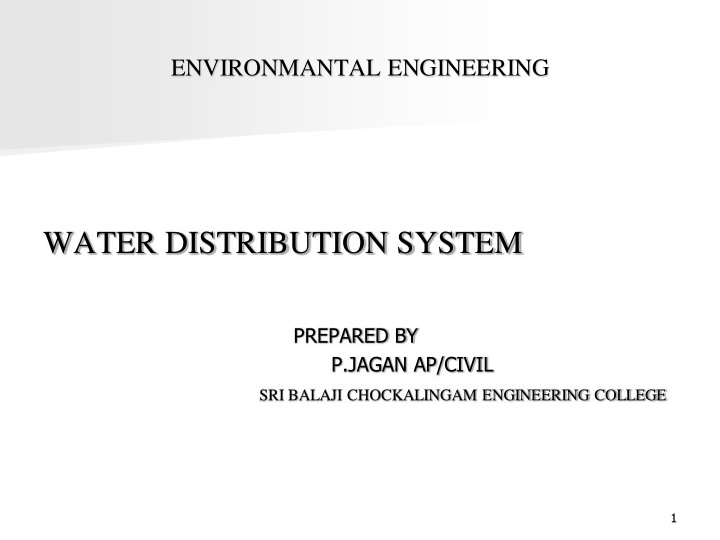



ENVIRONMANTAL ENGINEERING WATER DISTRIBUTION SYSTEM PREPARED BY P.JAGAN AP/CIVIL SRI BALAJI CHOCKALINGAM ENGINEERING COLLEGE 1
CTC 450 Water Distribution Systems 2
Objectives Understand water & pressure requirements Know the basics of providing water for fire protection requirements Understand the layout of water distribution systems Understand the basics of well construction and intake structures Understand the basic types of pipes Understand the basic types of valves 3
Water Quantity Daily consumption varies widely – 600 gpd per metered service including residential, commercial and industrial customers – 100-200 gpd per capita (80-150 gpd for residential) – 40 gpd per capita (using high-efficiency plumbing) Consumption also varies by season/day/hour Design of water systems must account for variation in municipal water consumption and water needed for fighting fires 4
MVWA 19.9 mgd average 126,250 people 158 gpcd 5
Water Pressure Distribution system (65-75 psi) Residential service connection (40 psi) Maximum pressure is 150 psi Pressures >100 psi are undesirable – more breaks, greater leaks, undue stress 6
Needed Fire Flow (NFF) Rate of water flow required for fire fighting to confine a major fire to the building within a block or other group complex with minimal loss. Insurance Services Office (ISO) – Guide for Determination of Needed Fire Flow 7
NFF Calculation Based on construction, occupancy, exposure and communication of each building in a building complex (see section starting on page 164) 8
Practical Limits Flow range could be 500 gpm (minimum) to 3500 gpm Automatic sprinklers are effective and minimize flows that must be required 9
Water Supply Capacity Gravity system is preferable (more reliable) Storage is used to equalize pumping rates and provide water for firefighting Pumping systems should be designed for reliability (electrical supply should be provided by 2 separate lines from different directions) 10
Distribution System Systems should be made redundant by interconnecting pipes into loops. Valves should be placed to allow repairs with minimal disruption to surrounding Fire hydrants should be installed at locations convenient for the fire department 11
Sources of Water Well Construction via drilling-hydraulic rotary or cable-tool percussion http://www.thewaterexperts.com/goodsservices.htm http://en.wikipedia.org/wiki/Drilling_rig#Cable_tool_drilling Surface-Water Intakes (rivers, lakes or reservoirs) 12
Piping Network Networks consist of storage reservoirs, main, booster pumping stations, fire hydrants and service lines Provide redundancy via grids and loops 13
Service Connections Corporation Stop connection from the distribution main (can be connected while the main is pressurized and in service) Installation http://www.freeed.net/sweethaven/BldgConst/Plumbing01/lessonmain.asp?iNum=fra0204 14
15
16
Kinds of Pipe Bell and Spigot Ductile iron Plastic (HDPE/PVC) Concrete Steel Residential (copper or plastic) 17
Pipe Strength Different pipes have different sizes and thicknesses Must use correct pipe to handle trench depth, bedding type, and live loads Must place pipe below the frost line to prevent freezing/breakage 18
Joints Compression Mechanical Flanged Solvent Soldered 19
Distribution Storage Use consumption curves to determine storage needed Look closely at example 6-5 20
21
Valves Gate/Butterfly/Swing Check (flow in one direction) Automatic Pressure-Reducing Valves Solenoid 22
Gate Valve 23
Butterfly Valve 24
Swing Valve 25
Other Valves Check Valve (permits water flow in only one direction) Pressure Reducing Valve (lowers pressure) Altitude Valves (controls flow into and out of a storage tank) Solenoid Pilot Valve (controls valve via electric current) Air release Valve 26
Fire Hydrants 27
Evaluating Distribution Systems Quantity Supply + storage must meet current daily demands (& future anticipated demands 10 years in the future – Reservoirs should have 30-day storage capacity – Wells should not “ mine ” water 28
Evaluating Distribution Systems Intake Capacity Intake structures – must be designed large enough to handle demand – Must be reliable 29
Evaluating Distribution Systems Pumping Capacity Pumps (should be reliable) – From source to water treatment plant – From water treatment plant clear-well to distribution system – Booster pumping stations 30
Evaluating Distribution Systems Piping Network Design life 40-50 years (actual 50-100) Large mains - 12” Submains- 6” or 8” 31
Question 1 What is the yearly average consumption of water per person per day? What does NFF stand for? What does gpcd stand for? What does MVWA stand for? What is a corporation stop? How does a check valve operate? 32
Recommend
More recommend